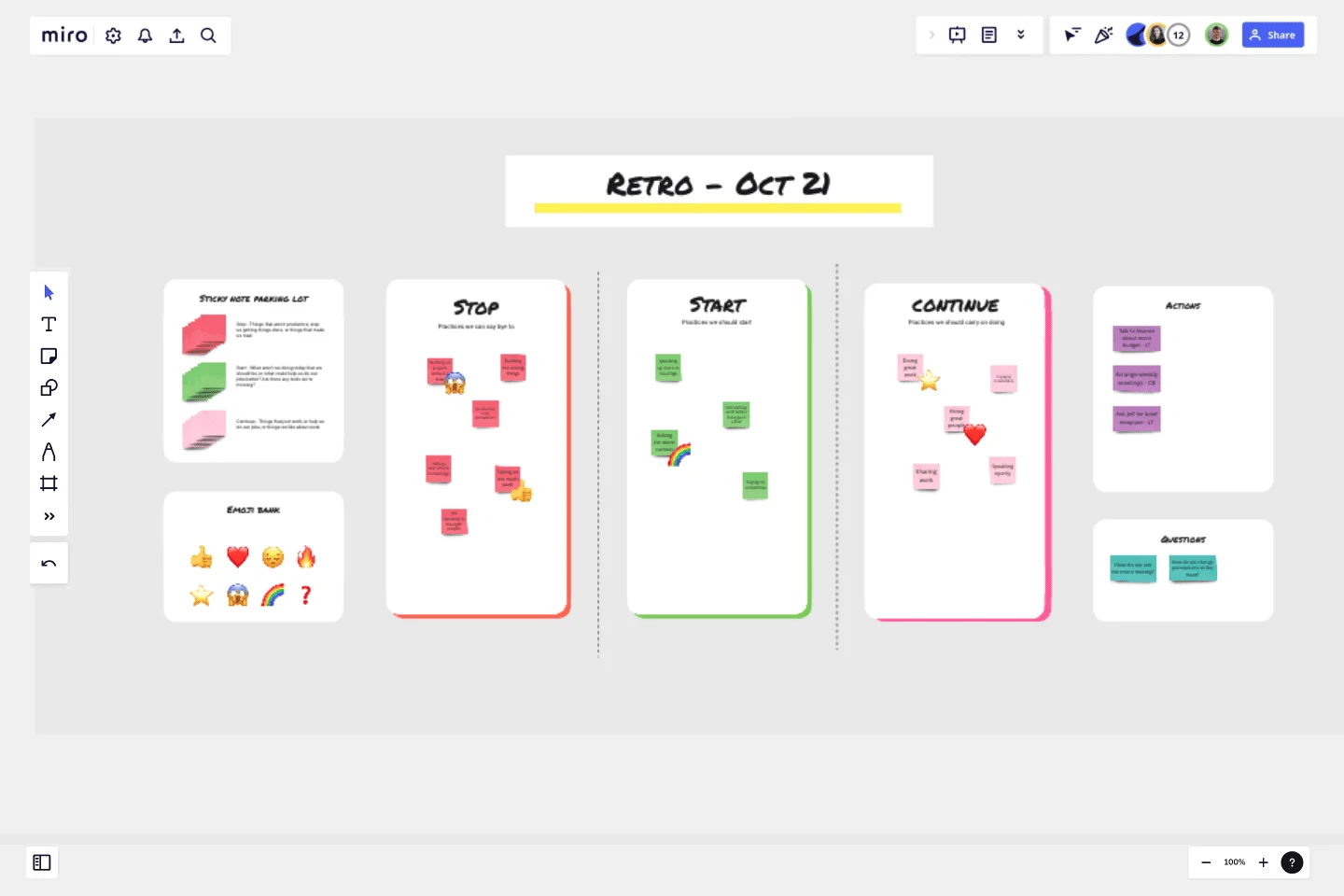Start, Stop, Continue Retrospective by Laura Timmins
A perfect remote retrospective template to get teams thinking about what in their current workflow works well, what needs work, and what do they need to start doing.
This doesn't need to be used at the end of a sprint or project - it can be used when forming teams to determine the best way to proceed successfully. If you haven't run a retro before, there are instructions and recommended timings for each part of the activity, and an idea of what you should be ending up with once the retro is over.
Participants: 2 - 10+ (one facilitator needed).
Time to complete: 15 - 90 mins dependant on team size.
Steps:
Try and use an icebreaker before to get everyone warmed up and ready to share
Ask everyone to spend 5-15 minutes writing sticky notes with items for each of the Stop, Start, Continue areas.
Once this has been done, spend a few minutes grouping these into themes for discussion.
If there is a lot of themes, tell the participants they have between 3 and 5 votes each. They then can vote to decide which topics should be discussed further.
Spend a few minutes discussing each topic, and try to write down actions for each to take away and address.
Tips:
Try to encourage the team to be open and honest.
Ask members to use emojis to react or emphasise different topics raised.
Ensure actions are assigned to individuals to take away to address changes needed.
This template was created by Laura Timmins.
Get started with this template right now.
Design Research Template
Works best for:
UX Design, Design Thinking, Desk Research
A design research map is a grid framework showing the relationship between two key intersections in research methodologies: mindset and approach. Design research maps encourage your team or clients to develop new business strategies using generative design thinking. Originally designed by academic Liz Sanders, the framework is meant to resolve confusion or overlap between research and design methods. Whether your team is in problem-solving or problem space definition mode, using a research design template can help you consider the collective value of many unrelated practices.
DMAIC Analysis Template
Works best for:
Agile Methodology, Design Thinking, Operations
Processes might not seem like the funnest thing to dive into and examine, but wow can it pay off—a more efficient process can lead to serious cost savings and a better product. That’s what DMAIC analysis does. Developed as part of the Six Sigma initiative, DMAIC is a data-driven quality strategy for streamlining processes and resolving issues. The technique is broken into five fundamental steps that are followed in order: Define, Measure, Analyze, Improve, and Control.
The 4-Step Retrospective
Works best for:
Retrospectives, Agile Methodology, Meetings
The 4-Step Retrospective template offers a simple yet effective framework for conducting retrospectives. It provides steps for reflecting on what went well, what didn't go well, what could be improved, and action planning. This template enables teams to systematically review past iterations, identify areas for growth, and implement actionable improvements. By promoting a structured approach to reflection and improvement, the 4-Step Retrospective empowers teams to drive continuous learning and enhancement effectively.
Service Blueprint by Hyperact
Works best for:
Research & Design
The Service Blueprint template is perfect for visualizing the orchestration of service components. It maps out frontstage and backstage elements, helping you analyze and enhance customer experiences. Use this template to align teams, identify pain points, and streamline processes, ensuring a seamless service delivery. It's ideal for creating a shared understanding of service dynamics among stakeholders and collaborators.
Quick Retrospective by Online Department
Works best for:
Retrospectives, Agile Methodology
The Quick Retrospective template offers a concise and efficient framework for teams to reflect on recent iterations or projects. It provides elements for sharing successes, challenges, and action items in a streamlined format. This template enables teams to conduct retrospectives quickly and effectively, even with limited time. By promoting efficiency and focus, the Quick Retrospective empowers teams to drive meaningful improvements and maintain momentum in their work effectively.
Improve Any Product - Product Management
Works best for:
Product Management, Planning
Improve Any Product - Product Management template provides a structured framework for enhancing product quality and performance. By analyzing customer feedback, identifying improvement areas, and implementing iterative enhancements, this template empowers product managers to optimize product features and functionalities. With sections for prioritizing enhancements and tracking progress, it facilitates continuous improvement efforts, ensuring that products meet evolving customer needs and market demands.
